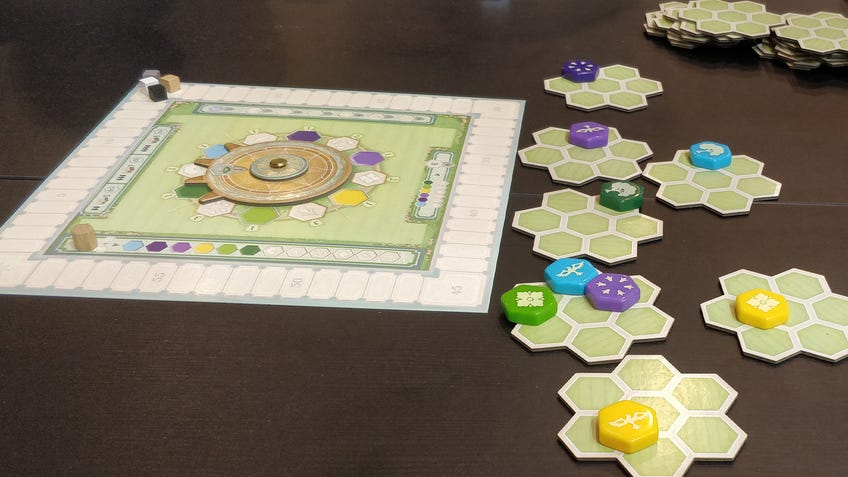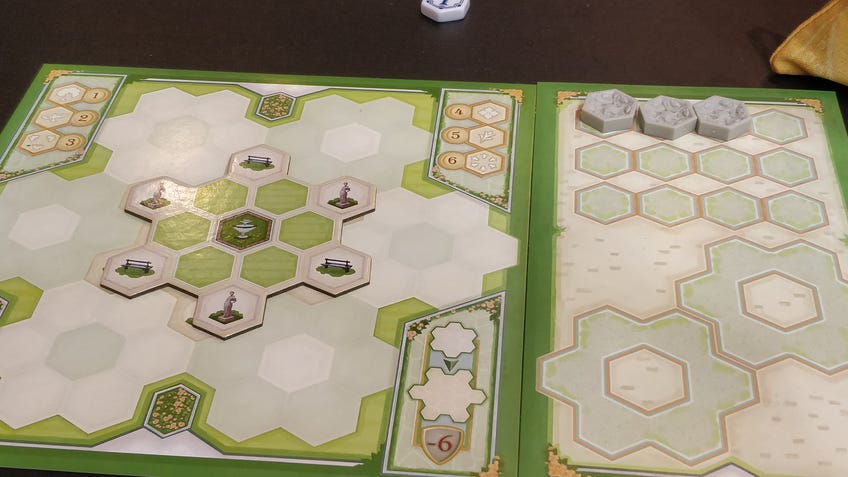Azul: Queen’s Garden sprouts fresh ideas whilst sticking to its roots
Wake up and play the roses.
Considering the simplicity of the original Azul, it’s surprising that designer, Michael Kiesling, continues to produce more and more follow-ups. The fourth entry in the series, Azul: Queen’s Garden, was revealed just last month and will be seeing a wider release later this year. Of course, if you happened to be at Essen Spiel 2021 - the biggest board game event in the world - this weekend, then you’d be able to get your hands on the game right there and then.
As soon as Dicebreaker arrived on the show-floor, I was looking out for Next Move, the publisher behind the Azul franchise, and quickly discovered the studio’s stand thanks to the sizable queue building up around its barriers. Clearly, due to the current COVID-19 pandemic, Next Move were aware of the need to space out convention-goers eager to try out Azul: Queen’s Garden. After a decent wait, I was eventually able to sit down and experience the new game for myself and it did not disappoint.

The first and most notable aspect of Queen’s Garden is the addition of a nifty little cardboard tower decorated to look like a palace complex, which reflected the game’s theme of the players being hired as garden designers for an important royal client. Another unique aspect of Queen’s Garden is its main board, which includes a dial that players spin at the start of each new round to reflect the current scoring bonuses - which is somewhat similar to Wingspan's round bonuses - alongside the standard points track. The player boards are not much different from those featured in the original Azul, besides the horticultural theme and the inclusion of some larger spaces intended to hold the newly introduced garden tiles that serve as additional areas to place tiles on.
Azul laid down the initial groundwork so that Queen’s Garden could plant far more elaborate designs within its soil.
The big difference between Queen’s Garden and its predecessors is how players interact with the series’ fundamental gameplay mechanics of drafting and tile-placement. Azul laid down the initial groundwork so that Queen’s Garden could plant far more elaborate designs within its soil, designs that force players to plan ahead and think carefully about their decisions in the same satisfying way that lovers of the series are used to.
Queen’s Garden takes place over the course of four rounds, with players able to perform three different actions throughout those rounds including drafting, tile-laying and passing. Drafting tiles has players taking it in turns to pick up sets of tiles off of flat garden tiles, before placing them within the storage section of their player-board as long as they have the space to do so. When drafting tiles players have the option to take all the tiles of the same colour or symbol, except for those tiles that are identical to each other - for example, players could only take one of two light green tiles displaying birds.
Having to consider how you’re going to pay for tiles, as well as which tiles you want to put into your garden, serves as an even greater test of your ability to think ahead.
Every one of the symbols shown on the tiles is worth a different point value that players could earn at the end of the game, but they also represent how much it costs to play that tile into a garden. Should a player ever want to place a tile in their garden they need to spend an amount of tiles - of either the same colour or symbol - equal to the point value of the one they want to place. For instance, a player could pay for a turquoise butterfly tile with two other turquoise or butterfly tiles. However, just as players cannot draft identical tiles, they also cannot pay using identical tiles. Having to consider how you’re going to pay for tiles, as well as which tiles you want to put into your garden, serves as an even greater test of your ability to think ahead and significantly rewards players who make clever decisions.

Though players are given points each round for having certain types of tiles in their garden, they’re scored at the end of the game based on how they’ve placed those tiles, with players only earning points for groups of at least three tiles that have either matching colours or symbols. This means that players are unlikely to win if they aim for the round bonuses only, instead they will need to consider how they’re going to create high scoring groups of tiles within their garden. Winning at Queen’s Garden requires a careful balance of round scoring and end of game scoring, which makes for an incredibly compelling gameplay loop which is further spiced up by the randomness of tile drawing and which tiles your opponents decide to take.
Azul: Queen’s Garden proves that the franchise still has plenty of ground to cover and delights to offer players, despite this being the fourth entry in a surprisingly simple series.
Even though I consistently found myself scoring miserably low at the end of each round, by acquiring, paying for and placing high value tiles into my garden within matching groups I was able to make a considerable comeback by the game’s conclusion, though I didn’t quite manage to best the enormous collection of yellow tiles placed by the impressively intelligent kid we were playing with. Seeing how each of us approached our individual gardens; whether we’d aimed to place tiles to match the round bonuses; or had tried to make the largest possible matching group; or had invested in higher scoring tiles, was a testament to the triumph of Queen’s Garden.
Azul: Queen’s Garden proves that the franchise still has plenty of ground to cover and delights to offer players, despite this being the fourth entry in a surprisingly simple series. All the familiar gameplay mechanics that players love about Azul are still very much there, but it feels like a different game offering a whole new challenge for players to dig into.

